Trevor B. Persons, Tom Aversa, Kyle A. Lima, Magill Weber, and Louis R. Bevier
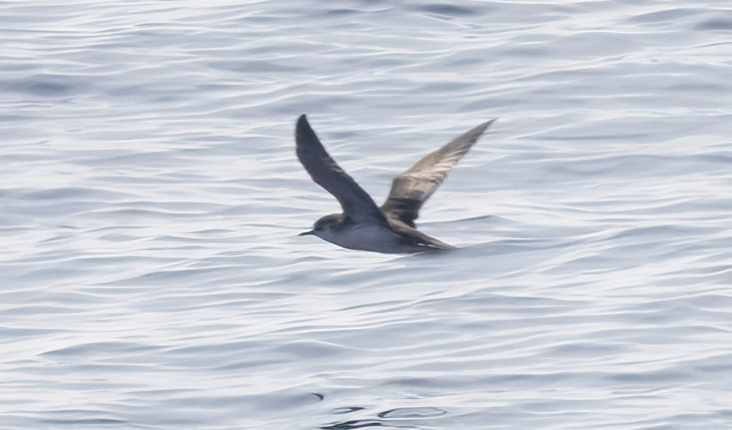
Maine’s first confirmed Barolo Shearwater was found in the middle of the Gulf of Maine on August 13, 2021. Photograph by Doug Gochfeld.
The Eleventh report of the Maine Bird Records Committee (hereafter ME-BRC or the committee) summarizes 85 reports involving 43 species that were evaluated and decided during 2021. The committee accepted 72 records for an acceptance rate of 85%. Although many reports were recent, the years of occurrences ranged from 1915 to 2021. The committee continued its quest to review a backlog of historic reports. Nearly half of reviewed reports (41) were birds recorded previous to 2018.
Three new species were added to the state list: Barolo Shearwater (Puffinus baroli), Masked Booby (Sula dactylatra), and Redwing (Turdus iliacus). In addition, the recent split of Mew Gull added one to the state’s total, as both Common Gull (Larus canus) and Short-billed Gull (Larus brachyrhynchus) had previously been accepted as subspecies of Mew Gull. The total number of documented species on Maine’s state list is now 467. The official list of bird species recorded in Maine, our review procedures, and the list of members can be found at the committee’s website: http://sites.google.com/site/mainebirdrecordscommittee.
Records in this report are grouped by species; records accepted and those not accepted are listed within the same species account. Each record provides the location, county (italicized), date(s) of occurrence, names of observers or contributors, and committee record number. Documentation was provided by the observers listed or, in some cases, was obtained from publicly published websites. All reviewed materials and member comments are archived. If known, the names of finders are listed first and separated from other names by a semicolon. Photographic, video, or audio evidence reviewed is denoted by a dagger (†); written notes are denoted by an asterisk (*). As always, the committee strongly encourages written submissions even when there are photographs. Species accounts follow the current taxonomic classification and sequence adopted as of 2021 by the American Ornithological Society (list available at http://checklist.americanornithology.org/taxa.
Species Accounts
Pink-footed Goose (Anser brachyrhynchus). Reports were accepted from Nobleboro, Lincoln, December 22–29, 2014 (Nicole Graffam; John Weinrich†, Louis Bevier†, Margaret Viens†; 2014-019) and Mars Hill, Aroostook, October 28–31, 2015 (Bill Sheehan†; 2015-019).
Barnacle Goose (Branta leucopsis). Two older reports were accepted: South Berwick, York, December 15, 2011, to January 11, 2012 (Jason Lambert, Doug Hitchcox, Paul Miliotis; Andrew Aldrich†, Rob Speirs†; 2012-027) and Fort Fairfield, Aroostook, October 13–15, 2014 (Bill Sheehan†; Jerry Smith†, John Wyatt, Clay Hardy; 2014-020). NOT ACCEPTED, ORIGIN QUESTIONED: A bird at Machias, Washington, June 18 to September 19, 2004 (2004-003) was considered a possible escapee given the unusual summer timing, as well as occurring shortly before the species became a regular fall vagrant to Maine.
Tundra Swan (Cygnus columbianus). Three immature birds were at Little Ossipee Pond, Waterboro, York, October 31 to December 11, 2020 (Roland Gendron; Louis Bevier†, Charles Duncan†, Doug Hitchcox†; 2020-045), and another was at Unity Pond, Waldo, November 15, 2020 (Tom Aversa†; 2020-048).
Eared Grebe (Podiceps nigricollis). Presumably the same breeding-plumaged bird from 2009 returned to the Sanford sewage lagoons, York, May 17 to August 12, 2010 (David Doubleday, Andy Aldrich; Marie Jordan†; 2010-021).
Western Grebe (Aechmophorus occidentalis). Maine’s fourth accepted record (with about 10 more unreviewed) was photographed off Sears Island, Waldo, January 26, 2017 (John Wyatt†; 2017-053).
Chuck-will’s-widow (Antrostomus carolinensis). Presumably the same singing bird—and possibly half of a breeding pair—from 2018–2020 returned to Orland, Hancock, May 15 to July 24, 2021 (Michael Good†; Rich MacDonald†; 2021-011). Another singing bird was voice-recorded at Kennebunkport, York, May 20, 2021 (David Doubleday†; 2021-033).
Rufous Hummingbird (Selasphorus rufus). An adult male visited a residence near Boot Cove, Lubec, Washington, September 6–11, 2012 (Juanita and David Pressley; Eileen Clark†; 2012-025). An immature female frequented a yard in Biddeford, York, October 17 to November 10, 2012, and was captured and banded on November 2 (Pat Moynahan, Marian Zimmerman; Doug Hitchcox†; 2012-028)
Rufous/Allen’s Hummingbird (Selasphorus rufus/sasin). An adult female Selasphorus hummingbird photographed at Pownal, Cumberland, July 31 to August 1, 2021 (Derek and Jeanette Lovitch†; Ethan Whitaker†; 2021-028) was likely a Rufous, but details in the photos were insufficient to eliminate Allen’s.
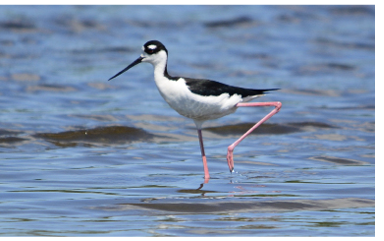
This Black-necked Stilt frequented Scarborough Marsh and nearby Stratton Island from June 17 to July 24, 2013. Photograph June 17 by Normand Bonneau.
Black-necked Stilt (Himantopus mexicanus). One was at Scarborough Marsh, Cumberland, and nearby Stratton Island, York, June 17 to July 24, 2013 (Normand Bonneau†; Louis Bevier†, Mike Fahay†, Margaret Viens†; 2013-027). This is only the second report accepted by the committee, with eight others (dating back to 1889) pending review.
Wilson’s Plover (Charadrius wilsonia). One was at Seawall Beach, Phippsburg, Sagadahoc, May 21–22, 1983 (Roger Muskat; Peter Vickery†, Denny Abbot†; 1983-002); this is the earliest record with physical evidence, the committee having accepted a sight report from 1953. Another made a brief appearance in Ogunquit, York, May 21, 2021 (Carolyn Grimes†; 2021-014).
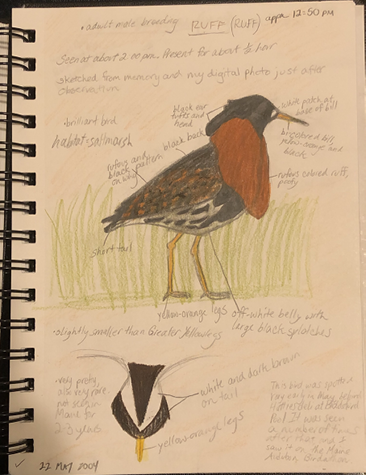
Apparently the only surviving documentation from an era before digital cameras became common birding accessories is this sketch of a breeding-plumaged male Ruff at Biddeford Pool May 14–26, 2004. Sketch May 22 by Luke Seitz.
Ruff (Calidris pugnax). Two older reports were accepted: one from Scarborough Marsh, Cumberland, July 27–August 4, 2002 (Lysle Brinker*; Howie Nielsen, Charles Duncan; 2002-003), and another from Biddeford Pool, York, May 14–26, 2004 (Todd Day; Luke Seitz*; 2004-004). The date ranges reported in Vickery and Duncan (2020) for the above differ: “27 July–3 Aug 2002 or later” (last date of August 4 is correct per C. Duncan in litt.); and “1–26 May 2004” (first date of May 1 lacks documentation and is assumed to be an error). An apparent immature female was photographed at Clinton, Kennebec, May 5, 2021 (Tom Aversa†; Louis Bevier†, Ethan Whitaker†; 2021-015). NOT ACCEPTED, IDENTIFICATION QUESTIONED: A bird at Scarborough Marsh, Cumberland, August 5, 2020 (2020-024) was possibly a Ruff, but the committee agreed that the description was inadequate to completely rule out other species.
Curlew Sandpiper (Calidris ferruginea). The oldest report so far reviewed and accepted by the committee was one at Biddeford Pool, York, August 3, 1957 (Rinda-Mary Payne*, Mr. and Mrs. E. Woodard Payne; 1957-001); this was originally published in Payne (1957). One adult was at Seawall Beach, Phippsburg, Sagadahoc, June 2–3, 1984 (Peter Vickery, Denny Abbott†; 1984-002). A juvenile, rarely encountered in the Northeast, was at Thomaston, Knox, October 3–9, 2002 (Mark Libby; Lysle Brinker†, Curtis Marantz; 2002-002). Although over a dozen historic reports remain to be reviewed, the species has not been seen in Maine since 2008.
Long-tailed Jaeger (Stercorarius longicaudus). One immature bird was photographed from Mount Desert Rock, Hancock, August 4, 2021 (Nathan Dubrow†, Levi Sheridan†, Tess Moore, Georgia Lattig; 2021-025).
Ivory Gull (Pagophila eburnea). A suite of records was accepted from years past. An immature, originally reported by Norton (1918), was at Portland, Cumberland, January 4–7, 1918 (Walter Rich; Arthur Norton*; 1918-001). An adult was captured at Boothbay Harbor, Lincoln, January 11, 1952 (Robert Davis; Alfred Gross†; 1952-001). The bird was given to Bowdoin College, where it was photographed and prepared as a specimen after it died on January 27, 1952 (Gross 1952); the current whereabouts of the specimen are unknown. An immature bird at Eastport, Washington, stayed from January 1–10, 1971 (Nellie Ross, Arlo T. Bates; David Libby†; 1971-002); a photograph was published in Finch (1971). Another immature enjoyed a Maine winter on Monhegan Island, Lincoln, December 30, 1986, to March 4, 1987 (Charles Duncan†; Dave DeReamus†, Peter Vickery; 1986-002). A more recent bird, also an immature, was off Swans Island, Hancock, December 21, 2020 (Charles Rabatin†; 2020-052).
Franklin’s Gull (Leucophaeus pipixcan). A breeding-plumaged bird, presumably the same individual, was seen at Cutler and then Machias, Washington, May 22 and then June 3–7, 1985, respectively (Charles Duncan†; Peter Vickery*; 1985-003). Two recent fall records of immatures were also accepted: Lamoine, Hancock, November 5, 2020 (Nathan Dubrow†; 2020-046) and Sanford Lagoons, York, September 9, 2021 (Robert Dixon†; 2021-035).
Common Gull (Larus canus). A well-described and sketched first-year bird was found at Martin’s Point, Portland, Cumberland, May 20, 2000 (Louis Bevier; Don Mairs*, Linda Woodard, Turk Duddy; 2000-002). The bird showed characters suggesting it was from European or western Asian taxa, probably nominate L. c. canus and not east Asian L. c. kamtschatschensis. Only the May 20th date is accepted. The committee does not have documentation to support the published date span of May 20–26 in Perkins (2000). This is Maine’s third and oldest accepted record of Common Gull, which is a recent split of Mew Gull into two species, the other being Short-billed Gull (L. brachyrhynchus), which has also occurred in Maine. Some older reports of Mew Gull have yet to be reviewed and the species involved determined.
Gull-billed Tern (Gelochelidon nilotica). NOT ACCEPTED, IDENTIFICATION QUESTIONED: A sight report from Harbor Island, Friendship, Knox, August 24, 1949 (1949-001) described the “short thick black bill” and “queer nasal katy-did-like call” as supportive characters but failed to describe the plumage (Cruikshank 1949). Although the observer was highly regarded and experienced with the species, the committee thought the documentation did not rule out the possibility of other species, such as Forster’s Tern (Sterna forsteri). Historic published accounts of sightings without physical evidence often do not provide careful details. Even though possibly correct, such sight records are perhaps best treated in a separate category.
Sandwich Tern (Thalasseus sandvicensis). A breeding-plumaged bird was at Biddeford, York, July 29, 1994 (Lysle Brinker†, Robby Lambert; 1994-007); the photograph originally published in Despres and Brinker (1994a) does not allow determination to subspecies. One photographed at Mount Desert Rock, Hancock, July 6, 2021 (Nathan Dubrow†, Levi Sheridan†; 2021-020) showed characters of Cabot’s Sandwich Tern (T. s. acuflavidus).
Red-billed Tropicbird (Phaethon aethereus). Maine’s famous and faithful Red-billed Tropicbird returned to Seal Island National Wildlife Refuge, Knox, for its sixteenth year from May 17 to August 7, 2020 (Keenan Yakola; Miles Brengle†, Tim Dunn†, Sophia Wong†; 2020-010) and its seventeenth year from May 6 to August 2, 2021 (Keenan Yakola, Elaine Beaudoin, Coco Faber; Ethan Whitaker†; 2021-009).
Pacific Loon (Gavia pacifica). A stunning breeding-plumage bird was encountered in Boothbay Harbor, Lincoln, October 11, 2021 (Derek Lovitch; Ian Carlson†, Ethan Whitaker†, and many others who submitted photos to eBird; 2021-039).
Yellow-nosed Albatross (Thalassarche chlororhynchos). An adult photographed from Matinicus Rock, Knox, July 6, 1999 (Anthony Hill†, Sue Schubel, and others; 1999-001), was published in Petersen (1999, page 363 and photos page 445). The committee started review but made no decision in 2006 given concerns by some members that Buller’s Albatross (Thalassarche bulleri) could not be eliminated. Circulation resumed in 2020, and the record was accepted in 2021. Current members noted that Buller’s shows extensive yellow on the bill that is visible at long range based on their experience. Thus, the all-dark mandible shown in the photos was thought real and supported Yellow-nosed. Minor subtleties of the underwing pattern also better fit Yellow-nosed, showing a slightly narrower black leading edge and broader black trailing edge than Buller’s. The gray wash to the head on the Matinicus Rock bird is typical of Atlantic Yellow-nosed Albatross (T. c. chlororhynchos). There are now seven accepted records of this species in Maine, with two older specimen records not yet reviewed.
Barolo Shearwater (Puffinus baroli). Maine’s first state record was found in the middle of the Gulf of Maine approximately 160 kilometers south of Bar Harbor, Hancock, August 13, 2021 (Doug Gochfeld†; 2021-029). The observer noted the small size as well as rapid and shallow wingbeat low to the water, which is thought to be characteristic of Barolo Shearwater. Photographs show a small black and white shearwater with a thin, short bill, an extensively pale face with the eye almost isolated therein, a limited extension of dark on the hindneck, extensively pale underwings, and a short tail. A few images of this distant bird show an apparent silvery bloom to the outer secondaries and thin white tips to the greater secondary coverts and possibly the median coverts as well. The closest relative and most similar species is Boyd’s Shearwater (P. boydi). The combination of mostly white face, limited dark in hindneck and two-toned pattern on upperwing along with the distinctive flight style described suggest the bird was a Barolo rather than a Boyd’s, which so far has not been documented in the northwest Atlantic (Flood and van der Vliet 2019, Robb and Mullarney 2008). Fresh-plumage Boyd’s may show thin white tips to upper wing coverts, but not the two-toned grayish bloom to wing (Flood and van der Vliet 2019). This bird was at the western end of the undersea feature called the Northeast Channel, which is the entry point for most of the Gulf of Maine’s pelagic waters between Georges Bank and Browns Bank. The mouth of the Northeast Channel, east of this sighting, is perhaps the epicenter of Barolo Shearwater observations in the western Atlantic Ocean (D. Gochfeld in litt.). There are at least nine other recent records from late July to late August spanning the waters south of Nantucket north to the mouth of the Northeast Channel, all since 2007. Two sightings south of Sable Island, Nova Scotia, by Bruce Mactavish, September 23–24, 2003, preceded the above and are seasonally the latest credible reports (Mactavish 2004). A specimen from September 1, 1896, at Sable Island, Nova Scotia, was the first North American record of the species (Lee 1988). Maine has one previous report involving a briefly seen bird located not far from the present record; that bird was reported October 30, 2019, and not accepted given the limited details and late date (Hitchcox et al. 2020).
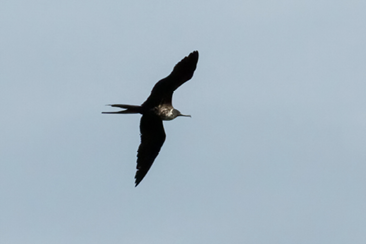
This Magnificent Frigatebird, the same individual seen from Nova Scotia south to Massachusetts, was at Appledore Island in the Isle of Shoals on August 20–21, 2021. Photograph August 20 by Jim Coyer.
Magnificent Frigatebird (Fregata magnificens). An older subadult male with black mottling on the breast was present at Appledore Island, Isle of Shoals, York, August 20–21, 2021 (Elizabeth Craig; Jim Coyer†, Heidi Levin†; 2021-030). The committee recognized the difficulty in ruling out Great (F. minor) and Ascension Frigatebird (F. aquila), but the lack of a white wedge at the base of the humerus on the underwing, which is retained into later plumage cycles on Ascension, probably eliminates that species as well as Lesser (F. ariel). Based on photographs showing the mottling on the breast and distinctive tail wear, this bird was the same individual seen—and better photographed—in Nova Scotia, New Hampshire, and Massachusetts as Hurricane Henri advanced north along the Atlantic coast.
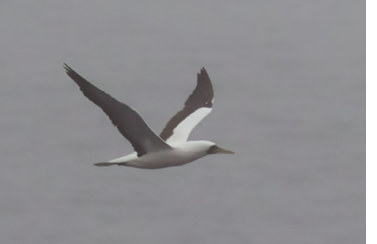
Maine’s first Masked Booby was a one-day wonder at Mount Desert Rock, a day after a Brown Booby was last seen on the island. Photograph August 9, 2021, by Nathan Dubrow.
Masked Booby (Sula dactylatra). Researchers on Mount Desert Rock, Hancock, documented Maine’s first Masked Booby on August 9, 2021 (Nathan Dubrow†; Georgia Lattig, Zach Aiken). Even more noteworthy, the Masked Booby came on the heels of a Brown Booby roosting on the island, putting this week in the record books as “The Rock’s”—and Maine’s—first back-to-back booby doubleheader.
Brown Booby (Sula leucogaster). An adult bird was at Great Duck Island, Hancock, July 27, 2021 (Jasper White†; 2021-023). This was likely the same bird that frequented Mount Desert Rock, Hancock, August 2–8, 2021 (Georgia Lattig; Nathan Dubrow†, Levi Sheridan†; 2021-024). NOT ACCEPTED, IDENTIFICATION QUESTIONED: A compelling sight report from Biddeford Pool, York, on July 8, 2021 (2021-021) was likely a Brown Booby, but the limited details observed at the great distance the bird was seen meant other, albeit less likely, species could not be eliminated, for example a dark immature Red-footed Booby (S. sula).
Swallow-tailed Kite (Elanoides forficatus). NOT ACCEPTED, IDENTIFICATION QUESTIONED: Three sight reports were intriguing but lacked sufficient detail to rule out the possibility of misidentifications: North Yarmouth, Cumberland, May 8, 2020 (2020-055); Deblois, Washington, October 10, 2020 (2020-054); and Harrington, Washington, May 23, 2021 (2021-017).
Mississippi Kite (Ictinia mississippiensis). A second-year bird was photographed at Sanford, York, June 17, 2015 (Josh Fecteau†; 2015-022). NOT ACCEPTED, IDENTIFICATION QUESTIONED: Although committee members agreed that a report from Warren, Knox, July 19, 2015 (2015-023) was likely correct given the reliability of the observer, the extremely brief sighting resulted in little reviewable evidence to support the observation.
Eastern Screech-Owl (Megascops asio). The committee accepted three reports from the Casco Bay islands off Portland, Cumberland. A whinnying bird was recorded on Long Island (John Lortie†; 2021-026) and was present from August 7 to at least September 28, 2021. Two reports from Peaks Island may represent the same rufous-morph bird: May 11, 2020 (Michael LaCombe†, Sam Wainwright, Patty Wainwright; 2020-053) and January 8 to February 26, 2021 (Sam Wainwright†, Patty Wainwright, Michael LaCombe; Michael Boardman†, Matthew Gilbert†; 2021-001). This species remains an enigma outside southern York County, where it is also sparsely reported.
Ash-throated Flycatcher (Myiarchus cinerascens). One was at Portland, Cumberland, October 23–27, 2015 (Bill Bunn; Gordon Smith†; 2015-025).
Sulphur-bellied Flycatcher (Myiodynastes luteiventris). NOT ACCEPTED, IDENTIFICATION QUESTIONED: The committee agreed that a sight report from Harpswell, Cumberland, September 27, 2021 (2021-038) by an observer familiar with Neotropical flycatchers was most likely a Sulphur-bellied. However, most members thought that other, albeit less likely species, particularly Streaked Flycatcher (Myiodynastes maculatus) and Variegated Flycatcher (Empidonomus varius), could not be eliminated and were not considered carefully at the time of observation.
Tropical Kingbird (Tyrannus melancholicus). The committee accepted an October 30–31, 1915, record of an immature male collected at Scarborough, Cumberland (George Oliver; 1915-001), originally reported by Norton (1916). Photographs and measurements taken of the specimen by Louis Bevier in 2005 demonstrated the relatively long, thin bill and wing-tip formula considered diagnostic for the species (Traylor 1979, Phillips 1994). Formerly catalogued as Portland Society of Natural History #773, the specimen was, as of 2005, housed in the collection of the Department of Zoology, University of Maine, Orono. This is a historically important specimen, being one of the oldest examples of long-distance vagrancy in Tropical Kingbird. This bird has been ascribed to the subspecies T. m. satrapa, which includes as a synonym T. m. chloronotus, under which name this specimen is found in older literature (Palmer 1949, American Ornithologists’ Union 1957; see Slipp 1942 for determination of subspecies by Herbert Friedmann). West Mexican populations of the subspecies satrapa are sometimes split as T. m. occidentalis; Pyle 1997 lists the Maine record under satrapa while recognizing occidentalis, but diagnosis may not be possible even if these subspecies are recognized.
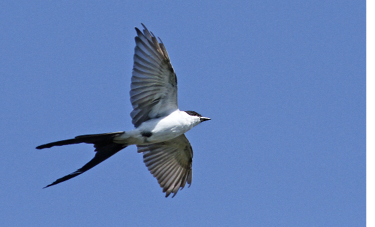
This adult male Fork-tailed Flycatcher at Stratton Island September 2–3, 2011, showed the number and extent of notched outer primaries typical of the nominate migratory South American subspecies Tyrannus savana savana. Photograph September 2 by Luke Seitz.
Fork-tailed Flycatcher (Tyrannus savana). Five reports were accepted, bringing the state’s total to eight, with about an equal number of historic reports yet to be reviewed. An adult at Kennebunk, York, October 1–8, 1976 (Richard Aaronian, Sibley Higginbotham†, Allen Thomas, Denny Abbott; 1976-001) was first reported, with a photograph, by Finch (1977). Photographs of a worn adult at Fort Foster, Kittery, York, May 18–31, 1994 (Judy Trull, Lysle Brinker†, Peter Vickery*; 1994-005) originally appeared in Despres and Brinker (1994b). A molting male was at Brunswick, Cumberland, June 22, 2012 (Colleen McKenna; Doug Hitchcox†, Louis Bevier*†; 2012-029), and a freshly plumaged adult male was at Stratton Island, York, September 2–3, 2011 (Luke Seitz†; 2011-021); photographs of the Brunswick and Stratton Island males showed notched outer primaries consistent with nominate T. s. savana. Finally, an immature bird was at Kennebunkport, York, May 21–22, 2021 (Laura Zitske; Doug Hitchcox†, Josh Fecteau†; 2021-013).
Loggerhead Shrike (Lanius ludovicianus). One was well described from Machiasport, Washington, June 10, 1990 (Louis Bevier, Fred Purnell; 1990-004). A regularly occurring species during much of the twentieth century—last confirmed breeding in 1975—but none have been documented from Maine since 2009 (Vickery 2020).
Rock Wren (Salpinctes obsoletus). Maine’s second record remained along the breakwater at Perkins Cove, York, from November 27, 2020, to February 1, 2021, where it delighted hundreds of birders (Diana Onacki†; Sean Hatch†, Henry Mauer†, and many others; 2020-051). This provides the first record with physical evidence including photos, videos, and audio recordings. The previous record was a well-described sight record.
Sedge Wren (Cistothorus stellaris). One heard at Waldoboro, Lincoln, May 22, 1996, led to the discovery of four or more individuals and potential breeding at that site July 15 to August 25, 1996 (Ted and Delia Mohlie; Don Reimer*; 1996-005). A singing bird audio recorded at Northeast Creek, Bar Harbor, Hancock, June 8–10, 1996, soon led to a pair on July 8 with a nest located July 23; these birds remained to at least August 1, 1996 (Chris Witt; Charles Duncan†; 1996-006). Both records were summarized by Despres and Brinker (1997). A migrant was photographed at Monhegan Island, Lincoln, on May 18, 2005 (Steve Walker; Geoff Dennis†; 2005-012). The only accepted record since 2015 was one at Searsport, Waldo, from June 22 to July 10, 2020 (Charlie Todd†; Tenzin Jampa†, Louis Bevier†; 2020-022). Although some reported two individuals, this was not definitively proven. This species has declined from uncommon breeder to rare vagrant over the last 40 years. In the future, the committee will only review historic records after 2000.
Redwing (Turdus iliacus). This Eurasian thrush was added to the state list with two accepted records of first-winter birds. The first at Pigeon Hill, Steuben, Washington, on January 8, 2021, was seen by a single observer who fortuitously photographed it (Chris Michaud†*; 2021-004). Another appeared in heavily birded Capisic Pond Park, Portland, Cumberland, where it was viewed by hundreds from January 29 to February 22, 2021 (Brendan McKay*; Chris Sayers†*, Louis Bevier*, Charles Duncan†, Henry Mauer†, Laurie Pocher†, Julian Hough†; 2021-005). It appeared to be an Icelandic-breeding T. i. coburni based on the overall bulkiness, dark legs, and heavy droplet-shaped spots on the flanks and undertail coverts (Yann Kolbeinsson, pers. comm.). The Maine records were part of an irruption that included at least ten reports from the Canadian Maritimes.
Lark Bunting (Calamospiza melanocorys). An alternate-plumaged, second-year male made a well-timed visit to Seal Cove, Tremont, Hancock, on May 29, 2015 (Edison Buenaño; Craig Kesselheim*, Becky Marvil†, Louis Bevier†*; 2015-024) that coincided with the Acadia Birding Festival. It represented only the second Maine record in the last 15 years for this vagrant to New England, which was formerly more frequent; it is also more typical in fall.
LeConte’s Sparrow (Ammospiza leconteii). A molting juvenile found at a working farm in Unity, Waldo, completed its molt to basic plumage from September 14 to 28, 2021 (Tom Aversa†*; Louis Bevier†*; 2021-040). It was the fifth record accepted by the committee, with several more yet to be reviewed. Because the arrival date is earlier than most regional records, this individual may have originated from a population in southern Quebec.
Western Meadowlark (Sturnella neglecta). A singing male that was photographed and audio-recorded at Norridgewock, Somerset, May 25 to June 14, 2001, was the first report reviewed and accepted by the committee (Wally Sumner; Louis Bevier†*, Peter Vickery; 2001-005). This report was previously published (Petersen 2001). Other older published reports await review. Coincident with the decline of Eastern Meadowlark (S. magna) in Maine over the past few decades (Joyce 2020), this western counterpart has become a less frequent vagrant to the state, with only one other report this century in 2002.
Bullock’s Oriole (Icterus bullockii). Two accepted records were part of an autumnal mini irruption into New England in 2020. An adult male in Freeport, Cumberland, remained from November 8 to 23 (Heather Baker†; Henry Mauer†, and many others; 2020-047), with another in nearly identical plumage photographed at Thomaston, Knox, on November 22, 2020 (Angela Osnoe†; 2020-049). At least one member thought that plumages of the two birds differed, and with the two sites approximately 30 miles distant, the committee accepted two orioles.
Golden-winged Warbler (Vermivora chrysoptera). A phenotypically pure second-year female was banded and measured at Falmouth, Cumberland, May 15, 2021 (Andrew Gilbert, Evan Adams, Patrick Keenan†*; 2021-010). NOT ACCEPTED, IDENTIFICATION QUESTIONED: The description of a bird seen by a single observer at Falmouth, Cumberland, September 29, 2021 (2021-036) was possibly correct but supported by a generic description insufficient to confirm this sight report.
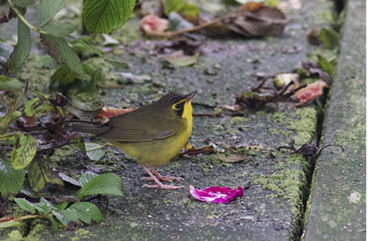
This Kentucky Warbler was at Mount Desert Rock August 24–26, 2021. Photograph August 24 by Nathan Dubrow.
Kentucky Warbler (Geothlypis formosa). A first-year male was at Mount Desert Rock, Hancock, on August 24 and 26, 2021 (Nathan Dubrow†*; 2021-031). A majority of accepted records of this warbler are from offshore islands, with almost all reports coming from coastal locales. NOT ACCEPTED, IDENTIFICATION QUESTIONED: A report of a singing bird heard but not seen at Brunswick, Cumberland, June 1, 2021 (2021-019) was not accepted because it was not recorded and the description did not effectively rule out other species.
Black-throated Gray Warbler (Setophaga nigrescens). Two records were endorsed, bringing the total accepted by the committee to five. One at Pond Cove, Cape Elizabeth, Cumberland, October 29–November 3, 2005 (Charlie Governali; Louis Bevier†*, Bryan Pfeiffer†; 2005-011) that was reported by Ellison and Martin (2006) was either an adult female or, more likely, a first-fall male. A first-year bird, probably a female, was found at Biddeford Pool, York, November 21, 2020 (Tara Yeackel†; 2020-050).
Black-headed Grosbeak (Pheucticus melanocephalus). A first-year male was at Capisic Pond Park, Portland, Cumberland, from January 14 to at least March 14, 2021 (Frank Paul*; Tom Foley*, Tom Aversa†, Charles Duncan†*; 2021-002). The bird was reported April 13 but was undocumented; thus, March 14 is the last accepted date. The bird’s molt progressed to more mature plumage during its stay.
Dedication
The Maine birding community suffered a loss when Patricia (Pat) Moynahan passed away on December 15, 2021. Pat served as a member of the ME-BRC from 2016 to 2019.
Acknowledgments
Thanks to Jeramiah Trimble for facilitating photo acquisition of the Monhegan Sedge Wren, and to Julian Hough for forwarding images of the Portland Redwing to Iceland for Yann Kolbeinsson’s subspecific confirmation.
References
- American Ornithologists’ Union. 1957. Check-list of North American Birds, 5th ed. Baltimore, Maryland: American Ornithologists’ Union.
- Cruickshank, A. D. 1950. Some Notes from the Audubon Nature Camp—1949. Bulletin of the Maine Audubon Society 6:8-9.
- Despres, J. and L. Brinker. 1994a. The Nesting Season: 1 June–31 July, 1994. Maine Bird Notes 7 (2):40–44.
- Despres, J. and L. Brinker. 1994b. The Spring Migration: 1 March–31 May, 1994. Maine Bird Notes 7 (2):26–39.
- Despres, J. and L. Brinker. 1997. The Nesting Season: 1 June–31 July, 1996. Maine Bird Notes 9 (2):40–48.
- Ellison, W. G. and N. L. Martin. 2006. Fall Migration: New England. North American Birds 60:37–43.
- Finch, D. W. 1971. The Winter Season: Northeastern Maritime Region. American Birds 25:547–553.
- Finch, D. W. 1977. The Autumn Migration: Northeastern Maritime Region. American Birds 31:225–232.
- Flood, R. L. and R. van der Vliet. 2019. Variation and identification of Barolo Shearwater and Boyd’s Shearwater. Dutch Birding 41:215–237.
- Gross, A.O. 1952. The Ivory Gull in Maine. Bulletin of the Maine Audubon Society 8:26–28.
- Hitchcox, D. P., T. Aversa, L. R. Bevier, and T. B. Persons. 2020. Ninth Report of the Maine Bird Records Committee. Bird Observer 48:96–105.
- Joyce, R. V. 2020. Eastern Meadowlark. In Birds of Maine. P. D. Vickery, C. D. Duncan, J. V. Wells, and W. J. Sheehan. Memoirs of the Nuttall Ornithological Club, No. 25. Princeton, New Jersey: Princeton University Press. pp. 519–520.
- Lee, D. S. 1988. The Little Shearwater (Puffinus assimilis) in the western North Atlantic. American Birds 42:213–220.
- Mactavish, B. 2004. Fall Migration: Atlantic Provinces & St. Pierre et Miquelon Region. North American Birds 58:30–32.
- Norton, A. H. 1916. Notes on some Maine birds. Auk 33:376–383.
- Norton, A. H. 1918. The Ivory Gull (Pagophila alba) at Portland, Maine. Auk 35:220–221.
- Orta, J., F. Jutglar, E. F. J. Garcia, and G. M. Kirwan. 2020. Red-billed Tropicbird (Phaethon aethereus), version 1.0. In Birds of the World (J. del Hoyo, A. Elliott, J. Sargatal, D. A. Christie, and E. de Juana, Editors). Cornell Lab of Ornithology, Ithaca, NY, USA. https://doi.org/10.2173/bow.rebtro.01
- Palmer, R. S. 1949. Maine Birds. Bulletin of the Museum of Comparative Zoology 102.
- Payne, R-M. 1957. A Curlew Sandpiper sight record. Maine Field Naturalist 13:83–84.
- Petersen, W. R. 1999. The Nesting Season: New England Region. North American Birds 53:363–366.
- Perkins, S. 2000. The Spring Migration: New England Region. North American Birds 54:259–263.
- Petersen, W. R. 2001. The Nesting Season: New England Region. North American Birds 55:411–415.
- Phillips, A. R. 1994. A tentative key to the species of kingbirds, with distributional notes. Journal of Field Ornithology 65:295–306.
- Pyle, P. 1997. Identification Guide to North American Birds. Part I. Bolinas, California: Slate Creek Press.
- Robb, M. and K. Mullarney. 2008. Petrels Night and Day: A Sound Approach Guide. Poole, UK: The Sound Approach.
- Slipp, J. W. 1942. Vagrant occurrences of Tyrannus melancholicus in North America. Auk 59:310–312.
- Traylor, M. A. 1979. Two sibling species of Tyrannus (Tyrannidae). Auk 96:221–233.
- Vickery, P. D. 2020. Loggerhead Shrike. In Birds of Maine. P. D. Vickery, C. D. Duncan, J. V. Wells, and W. J. Sheehan. Memoirs of the Nuttall Ornithological Club, No. 25. Princeton, New Jersey: Princeton University Press. pp. 397–399.
- Vickery, P. D. and C. D. Duncan. 2020. Ruff. In Birds of Maine. P. D. Vickery, C. D. Duncan, J. V. Wells, and W. J. Sheehan. Memoirs of the Nuttall Ornithological Club, No. 25. Princeton, New Jersey: Princeton University Press. p. 207.
